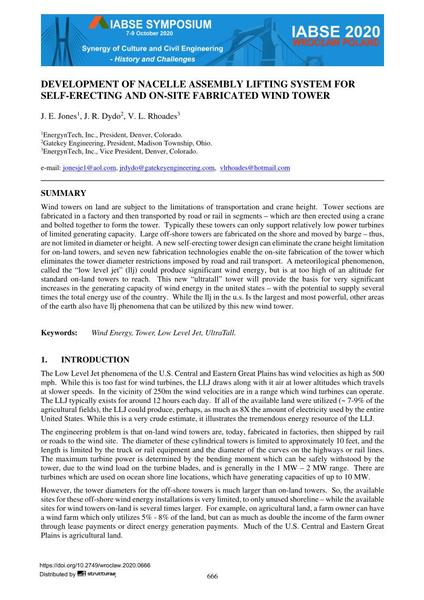Development of Nacelle Assembly Lifting System for Self-Erecting and on-site Fabricated Wind Tower

|
|
|||||||||||
Bibliographic Details
| Author(s): |
J. E. Jones
J. R. Dydo V. L. Rhoades |
||||
|---|---|---|---|---|---|
| Medium: | conference paper | ||||
| Language(s): | English | ||||
| Conference: | IABSE Symposium: Synergy of Culture and Civil Engineering – History and Challenges, Wrocław, Poland, 7-9 October 2020 | ||||
| Published in: | IABSE Symposium Wroclaw 2020 | ||||
|
|||||
| Page(s): | 666-675 | ||||
| Total no. of pages: | 10 | ||||
| Year: | 2020 | ||||
| DOI: | 10.2749/wroclaw.2020.0666 | ||||
| Abstract: |
Wind towers on land are subject to the limitations of transportation and crane height. Tower sections are fabricated in a factory and then transported by road or rail in segments – which are then erected using a crane and bolted together to form the tower. Typically these towers can only support relatively low power turbines of limited generating capacity. Large off-shore towers are fabricated on the shore and moved by barge – thus, are not limited in diameter or height. A new self-erecting tower design can eliminate the crane height limitation for on-land towers, and seven new fabrication technologies enable the on-site fabrication of the tower which eliminates the tower diameter restrictions imposed by road and rail transport. A meteorilogical phenomenon, called the “low level jet” (llj) could produce significant wind energy, but is at too high of an altitude for standard on-land towers to reach. This new “ultratall” tower will provide the basis for very significant increases in the generating capacity of wind energy in the united states – with the potential to supply several times the total energy use of the country. While the llj in the u.s. Is the largest and most powerful, other areas of the earth also have llj phenomena that can be utilized by this new wind tower. |
||||
| Keywords: |
tower wind energy Low Level Jet UltraTall
|
||||
